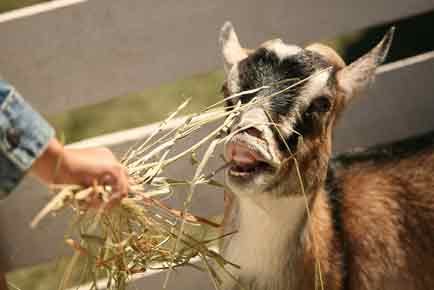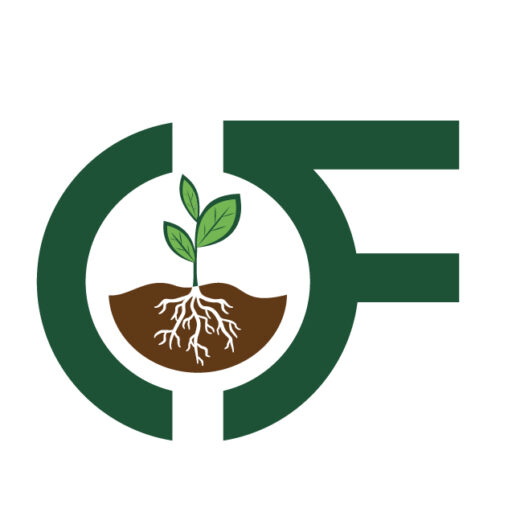The Ultimate Guide to Choosing and Using Hay Seattle has for Livestock
In the lush and often rain-soaked landscapes of Seattle, livestock owners face unique challenges and opportunities when it comes to selecting and utilizing hay for their animals. This guide is dedicated to helping you navigate these challenges, ensuring your livestock receive the best possible nutrition while also acknowledging our specific regional conditions because some people really don’t know where to buy hay in Seattle.

(Feeding the Goat hay.)
The Importance of Hay in Seattle's Climate
In Seattle’s climate, which is characterized by mild, wet winters and cool, relatively dry summers, hay plays a crucial role in agricultural and ecological systems. The region’s weather pattern, with its ample rainfall, is conducive to growing lush, nutrient-rich grasses, which are ideal for hay production. This makes hay an essential resource for local farmers, particularly those raising livestock. Hay serves as a primary feed source, especially during the colder months when pasture growth is limited. The quality of hay grown in this climate, rich in nutrients due to the fertile soil and ample moisture, contributes significantly to the health and productivity of livestock. This is particularly important for dairy and meat production, where the quality of feed directly impacts the quality of the final product, which is why proper storage is important for horse feed hay.
Moreover, hay cultivation in Seattle’s climate plays a vital role in soil conservation and ecosystem management. The practice of growing hay helps in maintaining the health of the soil, preventing erosion, and promoting biodiversity. The root systems of hay crops aid in holding the soil together, which is particularly beneficial in preventing runoff during Seattle’s heavy rainfalls. Additionally, rotating hay with other crops can enhance soil fertility and structure, leading to more productive and sustainable farming practices. This crop rotation also supports a diverse range of wildlife and beneficial insects, contributing to a balanced ecosystem. In essence, hay is not just an agricultural commodity in Seattle’s climate but a vital component of the region’s environmental stewardship efforts, underpinning sustainable agricultural practices and ecological balance.
Selecting the Right Hay for Sale Seattle Holds
Timothy Hay is a highly sought-after option, especially among horse owners, due to its well-balanced protein and fiber content. Known for its palatability and nutritional richness, Timothy hay is often favored for animals with moderate to low activity levels. Another popular choice in the hay market is Alfalfa Hay, recognized for its richness in protein, vitamins, and minerals. It’s particularly beneficial for young, growing animals, lactating females, and those with elevated nutritional requirements. However, its higher calorie and calcium content may not suit all animals, especially those prone to obesity or urinary issues. Orchard Grass Hay, on the other hand, is esteemed for its soft, leafy texture and mild sweetness, making it a preferred option for picky eaters. Mixed Hay combines various grasses and legumes, offering a well-rounded nutritional profile suitable for many animals. Oat Hay, derived from harvested oat plants, is notably higher in carbohydrates and is often reserved for more active animals or used as an occasional treat. Similarly rich in protein and nutrients, Clover Hay can serve as an excellent option for growing or active animals, although it should be fed in moderation due to its concentrated nature. Finally, Meadow Hay, composed of a mix of naturally occurring grasses and plants, provides animals like rabbits and guinea pigs with a diverse array of textures and flavors, promoting dental health and mental stimulation.
Seasonal Considerations:
- Timing of Cutting is crucial for optimal hay production, with late spring or early summer being the ideal period when grasses reach their peak nutritional value just before seeding. However, the exact timing depends on hay type and local climate. Weather Conditions play a significant role, necessitating dry, sunny conditions for hay curing in the field post-cutting. Moisture Content during baling is paramount; hay baled too wet risks spoilage, while overly dry hay loses nutritional value. Longer daylight hours in summer facilitate efficient hay curing, although extreme heat can lead to nutrient loss. Dew can interfere with drying, affecting hay quality. Frequency of Cutting varies, with multiple cuttings possible in a season, typically spaced 30-45 days apart, depending on growth rates and weather. Storage Preparations are seasonal, with hay needing a dry, ventilated space to prevent spoilage, crucial in regions with humid summers or wet winters. Frost late in the season can alter grass nutritional value and cutting timing, while Pest and Disease Management is vital year-round to safeguard hay quality.
Local Hay Suppliers:
Ohana Farms provides all types of hay for animals, visit their website at www.ohanahay.com or see their hay products.
Storing Hay in a Humid Climate
In the humid climate of Seattle, storing hay poses unique challenges. High humidity can lead to moisture retention in hay, which significantly increases the risk of mold growth and nutrient loss. This can not only diminish the quality of the hay but also pose health risks to livestock. To mitigate these risks, special care must be taken in both the storage facility design and the handling of hay.
Firstly, the choice of storage location is crucial. Hay should be stored in a well-ventilated area to allow air circulation, which helps in reducing moisture build-up. A covered barn or shed is ideal, as it protects the hay from direct exposure to rain and damp conditions. Within the storage area, hay should be kept off the ground to prevent moisture absorption from the soil. This can be achieved by using pallets or elevated platforms. It’s also beneficial to ensure that the storage area has a good drainage system to avoid water accumulation around the hay. Choosing the right amount of hay your animal needs goes a long way to helping not spoil the excess hay.
Nutritional Needs and Hay Quality
Understanding the nutritional needs of livestock and how they correlate with hay quality is essential for any livestock owner in Seattle. Different types of livestock require varying levels of nutrients such as protein, fiber, vitamins, and minerals, which are significantly influenced by the type and quality of hay they consume. For instance, dairy cattle and young, growing animals have higher protein requirements, often making legume hays like alfalfa a preferred choice. On the other hand, adult horses, particularly those with a lower activity level, may thrive on grass hays, like Timothy or Orchard grass, which offer a good balance of nutrients without excessive calories.
The quality of hay is a critical factor that directly impacts its nutritional value. Good quality hay should be green in color, have a fresh smell, and be free from excessive dust, mold, and weeds. The stage of maturity at which hay is harvested plays a pivotal role in its nutritional content. Younger plants have a higher protein content and are more digestible, whereas more mature plants have higher fiber content but lower nutritional value. In Seattle’s climate, timing the harvest can be challenging due to variable weather conditions, making it essential to source hay from reputable suppliers who understand the importance of harvesting at the right time.
Sustainable Hay Farming Practices in the Seattle Area
In the Seattle area, the emphasis on sustainable hay farming practices is growing, as farmers recognize the importance of environmental stewardship and long-term agricultural viability. Sustainable hay farming involves practices that not only yield high-quality forage but also protect and enhance the natural resources. One of the key practices is crop rotation, which prevents soil depletion, reduces pest and disease buildup, and can even improve hay quality. By rotating hay with other crops, farmers can naturally replenish soil nutrients and maintain soil health, essential in the often damp climate of the Pacific Northwest. Another practice is the use of organic fertilizers and natural soil amendments. Instead of relying on chemical fertilizers, sustainable farmers often use compost, manure, and other organic matter to enrich the soil, which not only boosts the nutrient content but also enhances the soil’s water retention capability, a crucial factor in a region known for its variable weather conditions.
Moreover, integrated pest management (IPM) is increasingly adopted by hay farmers in the Seattle area. IPM strategies focus on using biological and cultural controls to manage pests, reducing the reliance on chemical pesticides. This approach not only helps in maintaining the ecological balance but also ensures that the hay is free from harmful residues, which is particularly important for livestock health. Water conservation techniques are also vital in sustainable hay farming. Even in a region with ample rainfall like Seattle, efficient irrigation systems and water management practices are essential to prevent water wastage and runoff, which can lead to soil erosion and nutrient leaching. Sustainable hay farming in Seattle also often involves community engagement and education, where farmers share their practices and knowledge, fostering a culture of sustainability and cooperation. These practices not only contribute to producing high-quality hay but also ensure that the farming methods are environmentally sound and economically viable, benefiting both the local community and the ecosystem.
Community Resources and Support
The Seattle area, renowned for its strong sense of community and environmental consciousness, offers a wealth of resources and support systems for individuals involved in hay farming and livestock care. One of the key resources is the network of local agricultural extension offices. These offices, often associated with state universities, provide invaluable support to farmers and livestock owners. They offer expert advice, educational programs, and workshops covering a range of topics from sustainable farming practices to animal nutrition. These extension services often conduct hay quality analyses, which can be a crucial tool for farmers and livestock owners to ensure they are providing the best possible diet. Additionally, they often facilitate community events and forums where farmers can share insights, challenges, and solutions, fostering a collaborative environment.
Moreover, Seattle’s farming community benefits from a variety of local farming alliances and cooperatives. These organizations are instrumental in advocating for farmers’ interests, providing a platform for collective bargaining, and offering shared resources like equipment rental and bulk purchasing of supplies. They also serve as a hub for the exchange of knowledge and experience among members, promoting best practices in hay production and livestock management. Furthermore, Seattle’s proximity to numerous farmers’ markets and organic food networks provides an excellent opportunity for hay farmers to connect directly with consumers and other local businesses. This direct connection not only allows farmers to understand the needs and preferences of their customers but also helps in building a sustainable, community-supported agricultural system. Through these networks and resources, individuals in the Seattle area are well-equipped to engage in efficient, sustainable, and community-oriented hay farming and livestock management, contributing to the overall health and sustainability of the local agricultural ecosystem.
Conclusion:
The emphasis on sustainable farming practices highlights the region’s commitment to environmental stewardship and long-term viability of agricultural resources. Additionally, the wealth of community resources and support available in Seattle empowers farmers and livestock owners to make informed decisions, foster sustainable practices, and build a strong, cooperative agricultural community. Whether you are a seasoned farmer or new to livestock care, this guide is an invaluable tool in ensuring that your animals receive the best possible care and nutrition, tailored to the specific conditions of the Pacific Northwest.

